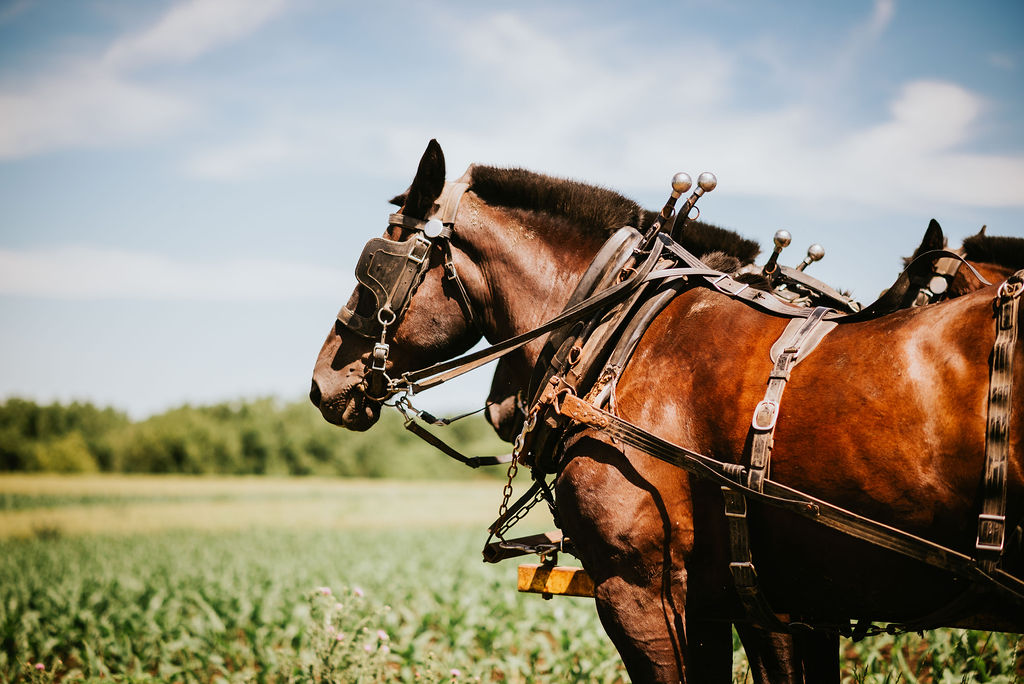Horse Power
The young farmer who owns this farm purchased it from his dad, who spent many years looking for just the right farm for his son. Already certified organic when he bought the property, it is surrounded by other organic farmers, a woodlot, and land in the USDA Conservation Reserve Program. This farm is on the edge of the Driftless Region in Western Wisconsin, where rolling hills dominate the landscape and ridge tops are often wide open, windy, and highly erodible. Small family dairy farms like this one still occupy areas where steeper slopes make the land difficult to farm with large machinery and make farms like this one well suited to contour farming with horses.

Contour farming along ridge lines was a widely implemented farming practice across the US to help stem the loss of topsoil that occurred during the dust bowl. Instead of having wide open fields that run up and down hills, contour farming uses strips that run across the hills. This has a wide range of benefits, mitigating the negative impacts of floods and storms by reducing soil erosion, controlling runoff water, and increasing moisture infiltration and retention.

Horses are very important to this farmer. After starting farming with Percherons, which are a breed of draft horses that are known for their intelligence and willingness to work (and beauty, just look at those horses!), he has continued to breed his Percherons to improve their conformance and performance as part of his team. In the spring, he will hitch 8 horses together, in two rows of 4 horses, to prepare the soil and plant. He can prepare 8 to 10 acres a day this way. Later in the year when cutting hay or harvesting he will hitch 6 across. Young draft horses are hitched on the outside and learn by following the more experienced horses next to them.

There are a wide range of environmental and social implications of farming with horses, particularly in highly erodible mountainous and hilly regions. In regions such as this, using heavy machinery can result in severe degradation of soil quality, particularly where forest soils are poorly developed. Soil disturbances and compaction from machinery often cause erosion which results in a dramatic decrease in soil fertility. It also causes changes in soil structure, which impacts its ability to infiltrate water. In contrast, farming with horses enhances soil structure, enabling it to better retain water. Their manure enhances fertility and augments the soil’s humus content, which sequesters carbon.
A comprehensive whole lifecycle environmental analysis done in northern Italy, an alpine region, found that the environmental impacts of farming with horses were 96.9% lower than the impacts of mechanical traction. See reference below. In addition, horses are powered by feed that can be grown on the farm, creating a self-sustaining ecologically based system instead of one that requires hydrocarbon fuels purchased off farm.
For more on the benefits of farming with horses, see:
Alessandro K. Cerutti, Angela Calvo, Sander Bruun, “Comparison of the environmental performance of light mechanization and animal traction using a modular LCA approach”, Journal of Cleaner Production, Volume 64, 2014, Pages 396-403, ISSN 0959-6526
https://doi.org/10.1016/j.jclepro.2013.09.027
For more on the benefits of contour farming, see:
https://kansaspermaculture.org/blog/four-benefits-of-contour-farming
A note about our photos: We are excited to use photos to connect you to the farms that supply milk for your Organic Squeaks so you can learn about the wide range of eco-active practices they use. Unless noted otherwise, these photos were taken on this farm by a photographer who is also one of our farmers. We respect the culture and privacy preferences of our farm partners, which is why you won’t always see people in our photos.

